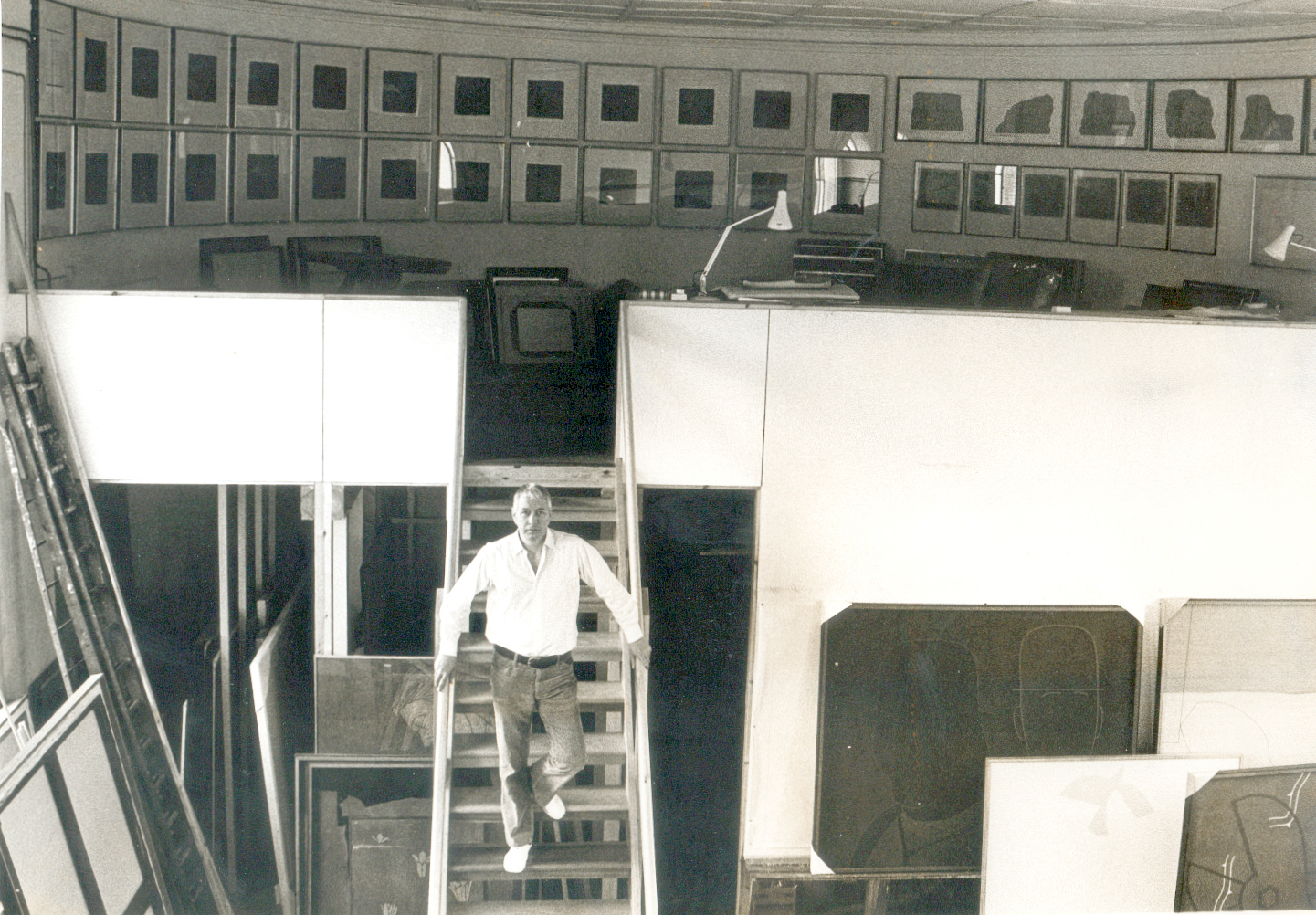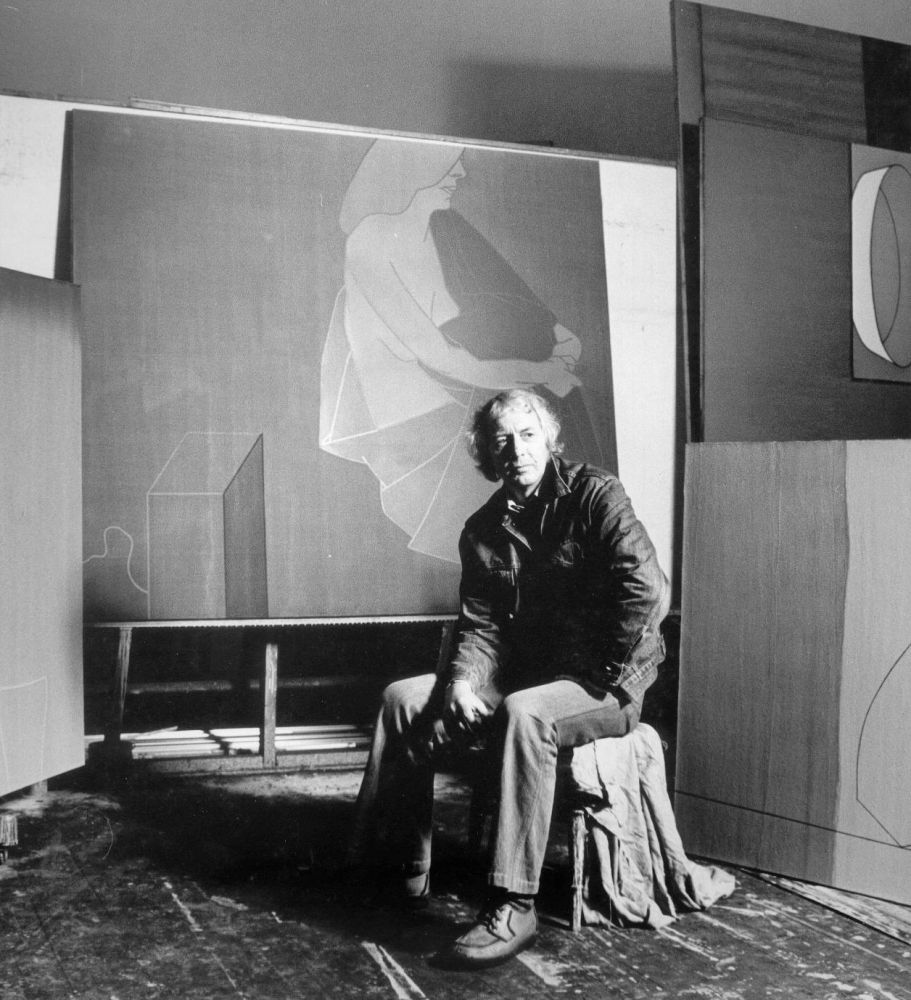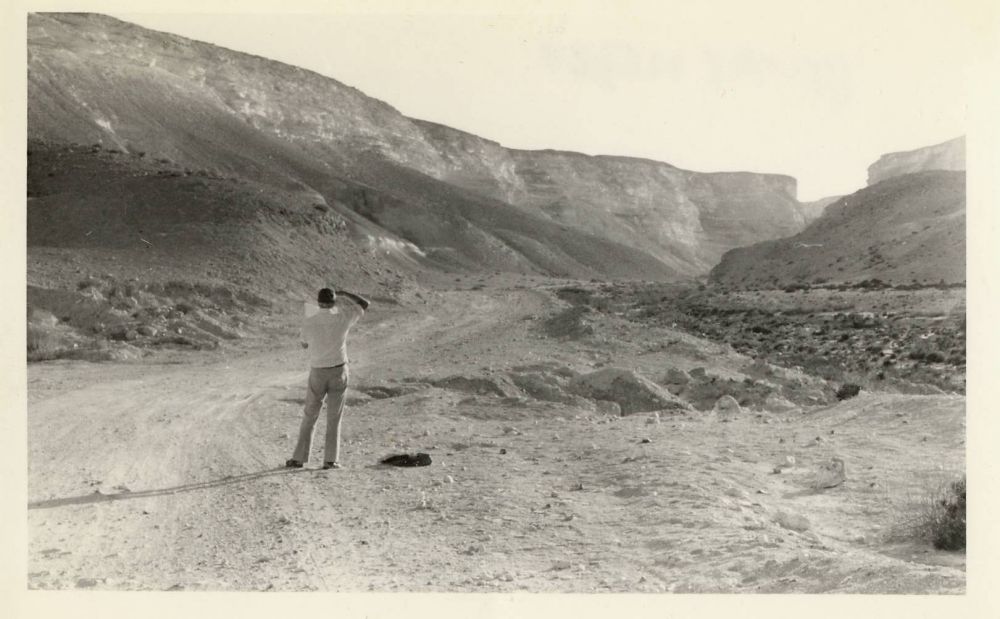In the 1970s, having pared down his vocabulary, Greaves set about enriching his imagery. The iconographic complexity increased in two new ways: first, through the incorporation of words and then through the fortuitous adoption of collage, not just in works on paper, but in large-scale canvases.
Discussing his work during this period, Greaves stated: Each painting has a particular logic or lyricism which declares itself during the process of painting only gradually. It is so easy to damage and thus lose the life or heart of the image by misunderstanding this slowly unmasking and uncompromising logic - which may be/is peculiar and particular to the image. Restructuring his language allowed Greaves to incorporate words in order to introduce a narrative element into strongly formal compositions. At a time when even figurative artists adopted a Modernist rhetoric which rejected narrative or storytelling - most famously and articulately in the interviews given by Francis Bacon - Greaves's sardonic response was to introduce actual words and narratives to accompany highly pared-down images. Greaves had already written narratives in his notebooks and in several paintings of the 1970s and 1980s he incorporated pre-existing words, phrases, sentences and even stories.
A precursor to these paintings was an earlier picture, Ladder (1976) in which a ladder in the centre of the picture is accompanied by the words 'sudden fierce rain silences the birds'. This disrupted image is made even more disjointed by the staccato words. Just as collaborating with Edward Middleditch on The Four Seasons mural (1957) had taken Greaves in new directions, so too did the chance to work creatively with the poet Roy Fischer. The 'concrete poets' were not part of Greaves's social circle but this was a fruitful collaboration. The two men were introduced by Ian Tyson of the Tetrad Press and initially Fischer suggested a dialogue by post in which the poet would send a line and Greaves an image to produce a series of works. Fischer's first missive was 'We are settling in among the stacks'. However, the correspondence foundered and a new way of working was devised. The idea was for a series of prints with an accompanying poem, entitled Also (1972) , which when exhibited in a line around a small room would be intimate and decoratively continuous, in that the poem would go round and round, seemingly eating its own tail.
As with the earlier mural, Greaves again improvised as part of the creative process. Sharing with Fischer a love of piano-jazz - Fischer is also a pianist - Greaves worked with the printer Chris Prater to make jazz-like improvisations moving from colour to colour in a spontaneous way. The prints marked a significant re-engagement with the medium, anticipating the centrality it would later assume and led to the creation of several paintings that prominently include lines of text.
Words act in different ways in these paintings. One such painting, Word Painting I (1976), contrasts an idyllic holiday view of sailing boats with the mundane realities of a shopping list: 'onions, wine, sausage, coffee, cheese?' Another, Word Painting II (1976) , shows crossed arms and inventories household furniture: 'sofa, dining chairs, table, umbrella stand, large cabinet, bed'. Other paintings are entirely word based, a witty riposte to a conversation in which the artist Jo Tilson had argued that it was no longer possible to do narrative painting. The resulting paintings also contained autobiographical elements such as allusions to Greaves's marriage. In Narrative Painting I (1978) and Narrative Painting II (Karen his wife) (1978) lines of words fill the entire picture surface with a short story.

[Derrick Greaves in his Studio in Woburn]
Collage was the other major development. In 1975, there was a flood at Greaves's studio in a converted chapel in Woburn. Water pipes burst and for four days while the artist was away water poured down the walls. The mezzanine was flooded, destroying five years of prints, which he had been holding back for a show, as well as drawings and watercolours by friends, and much of his library, although the paintings on the floor below were largely unscathed. When Greaves returned the wallpaper was peeling from the walls and after the shock of the devastation Greaves realised that the lining paper might be salvageable. Covering some old paintings in fragments of this paper, Greaves embarked on a series of drawings on a scale he had never previously attempted. The informality of the collage was just what Greaves had responded to in Pisa, its apparent randomness setting up a tension with the formality of the drawn line. The result would have implications not only for Greaves's practice as a draughtsman but also as a painter: 'I would draw whole figures life size - always an ambition. By drawing across the torn areas I became aware of the inner formal dialogues emerging between the accidentally informal ground and the imposed more formal drawing. Because of this stimulating and surprising inner life the drawing was able to be firmer, far less figuratively descriptive.developed a new diagrammatic way of drawing that was informal and chancy. The ground allowed a new schematic way of working that set up a dialogue between this ground and the figure. This is especially evident in the way that this took Greaves's still-life paintings in a new direction. The image of a flower and a vase is a recurring motif in Greaves's work, from prints to drawings to vast canvases. Through such images one can trace Greaves's preoccupations from the Braque-ian concerns of the early 1960s and the Matissean refinement of the mid 1960s, through to the increasingly heraldic imagery of later years, which at times has the emblematic quality of a florist's sign. Indeed, by the mid 1970s these flower paintings were often extremely decorative, something Greaves tempered in two ways: iconographically through the introduction of a political dimension and the incorporation of more violent ingredients such as a knife, and formally through the creation of collage grounds whose active presence provided a new tension.

[Woburn studio c.1970]
The tension, created by the coexistence of different languages, is even more overt in large figurative works of the later 1970s such as Entering a Room with Difficulty (1979), Confidences or The Introduction of Geometry (1979) and The Actress Entertained (1979). The combining of different types of line also prefigures the way in which recent works have allowed for the coexistence of different visual languages with individual elements rendered in distinct and separate styles.
The results of this new direction were presented in a powerful exhibition at Fischer Fine Art in 1980. Including 25 'collage drawings', all of which had minimum dimensions of around 3ft (1m) and rose to as much as 8ft (2.5m), these were 'drawings' on an epic scale that used a canvas rather than paper ground. With respect to the role given to line, the classification as 'collage drawings' was wholly appropriate, but given that they are on canvas the term 'collage paintings' perhaps better reflects the forceful presence and scale of works such as An Eclipse of Childhood (1979) .
The exhibition revealed that as Greaves's first marriage came to an end, the subject of relationships had found its way to the foreground of his work. A series of double portraits among them a strong depiction of Victor Musgrave and Monika Kinley, are some of the most charged pictures of his career. Just as his still-lifes often pared down forms and explored the interstices between them, so these portraits used formal elements such as separate and overlapping forms to convey a psychological charge. In exploring the complexities of marriage, corroboration was provided by Greaves's appreciation of D.H. Lawrence, who had originally wanted to give Lady Chatterley's Lover the title 'Tenderness'. For Greaves, his own portraits were about 'tenderness or frustrated tenderness', which also fuelled his prints on the theme of the lesbian poems, Chanson de Bilitis.
Greaves's double portraits are of relatives or close friends and deploy a stripped-down graphic language to express the varied and complex character of each subject. Yet there is also a psychological frisson to many of the more allusive works of this period, works in which Greaves sets up a dialectic between elements, whether they are objects or people. This period also coincided with some of the most acutely psychological portraits of Greaves's career, including a series of portraits of the art dealer Edna Reed, then going through a divorce, that have a highly sprung tension, and a powerful portrait of his first wife.
Greaves's use of collage was also put to good effect in his response to a visit to Israel. In 1979, Greaves was invited to visit Israel to produce work for an exhibition to be staged both in Tel Aviv and back in England. Keen to go to the Negev and stay on a kibbutz, he stayed at Sde Boker, a kibbutz specialising in alternative technology to make the desert more productive. Greaves would walk in the desert alone, overwhelmed by the lonely, silent, beautiful place. At a loss as to how to respond to its past, present and future, Greaves found the country disturbing on many levels. He visited the tomb of David Ben-Gurion, the former Israeli Prime Minister, and, as the fighter planes roared overhead, he did some rubbings of the stones on the grave. Then, in the early hours of the morning, unable to sleep he started drawing on these rubbings, creating his own Negev landscapes. Back in England these became the basis for large-scale paintings over collage grounds. The diagrammatic, schematic drawing contrasted with the accidental, organic nature of the grounds, an equivalent of the imposing of borders over the desert. Some of the most elaborate Negev collage-canvases, included foot wide frames that incorporated further collages: one was called Night and Day in the Desert (1979-80) another had a map-like border and declared its location, Negev, in bold Hebrew lettering. In many cases harsh shadows are given the substantiality of objects.

[Greaves in the Negev Desert]
Amongst the most successful responses were the most pared-down works. A small series showing parched plants gain much of their power from their large size and possess a grandeur that belies their delicate forms and economic, though precise, drawing. In contrast, another powerful Negev painting, The Greening of the Desert (1981-5) is an altogether richer experience. Plants are no longer leafless but bud, and the stripped down colour of the desert is replaced with rich colours, not an equivalence of the experience so much as an idealised view of a Utopian future in which the desert blooms. The surprising blue alludes to the desert dweller's life and death obsession with water.
In another collage painting, Asleep in the Desert (1981-5), Greaves alludes to the pervasive sense of history: the Adonis-like figure has the quality of classical sculpture and the pose of a forever sleeping Pompeian. A related painting shows another male figure, this time identifiable as a rare, all be it veiled, depiction of the artist, but now the keynote is not calm but anxiety, not comfortable repose in an untroubled environment, but hands up in defence, mouth open in anguish and a sense of threat provided by the fighter planes. The work is entitled Self Portrait of the Artist as Madman (King Kong) (1986) and the traces of a building could be a skyscraper but the state of anxiety is surely rooted in Greaves's disturbing experience of the Negev.
Self Portrait of the Artist as Madman (King Kong) also contains echoes of an occasional leitmotif in Greaves's paintings, the fall of Icarus. As a student he won a prize for a lithograph on the subject. At a difficult time in the late 1950s he again depicted Icarus in pastel and around the time of Self Portrait of the Artist as Madman (King Kong), he produced two large collage paintings on the subject. Each serves as a surrogate self portrait in its expression of the artist's anxieties. Given such a reading and the rarity of such autobiographical elements elsewhere in Greaves's work, it is hard not to consider The Little Pedagogue (Self-Portrait as Teacher) (1985) as a foil to Self Portrait of the Artist as Madman (King Kong). A self portrait of the artist as a teacher, all that is discernible is the artist's hand and pointing fingers against the ironic certitude of triangles and primary colours. But instead of a loss of equilibrium or fall from grace, there is a sense of control, of composure and authority.
The reconstruction of experiences with a strong emotional and psychological dimension remains present in later work, however schematic the drawing. In The Green Room (1982-4) the line is firm and the structure tight, emphasised by the Euclidian right angle created by the woman's compact. Ambiguity adds another dimension. The title suggests that we are backstage, as do the masks which partially or completely cover the woman's face, but perhaps the clue is the compact that she holds, suggesting that what we see may be the image of the woman reflected in her mirror. The mask serves to reflect the difference between how we see ourselves and how others see us, while the backstage setting further emphasises this theme of artifice and disguise, suggesting the ways in which we may mask our true selves.
The painting also alludes to the overt eroticism of many of Greaves's paintings, drawings and prints, especially during the 1970s and 1980s. In addition to the major print series, The Songs of Bilitis (1977), Greaves also made explicit watercolours (many of them still unexhibited) and large-scale paintings with a sexual dynamic. Above all, the nude took on a new importance in drawings and paintings of new models, among them Joanna Field and Sally Butler (later the artist's second wife). Taking them as a starting point, Greaves transformed them into fantastic creations of an altogether different type. Seeking to combine 'the vulgar and quotidian' with 'the erotic and the humorous', there is at times a glorious absurdity to these large-scale paintings. Admiring the erotic distortions of Ingres's late paintings such as Les Bains Turcs, Greaves eroticised existing motifs as in Spanish Rococo (1990), Lamp (1995) and a series of related paintings. In contrast to their fleshy heat, Demanding and Reluctant Love (1994) despite the title, is relatively restrained, attracting comparison with Matisse when it was shown at the Royal Academy Summer Exhibition in 1998. What followed burst with new energy, singing colour and brilliant dynamism.

[Photograph of Lamp in Studio]